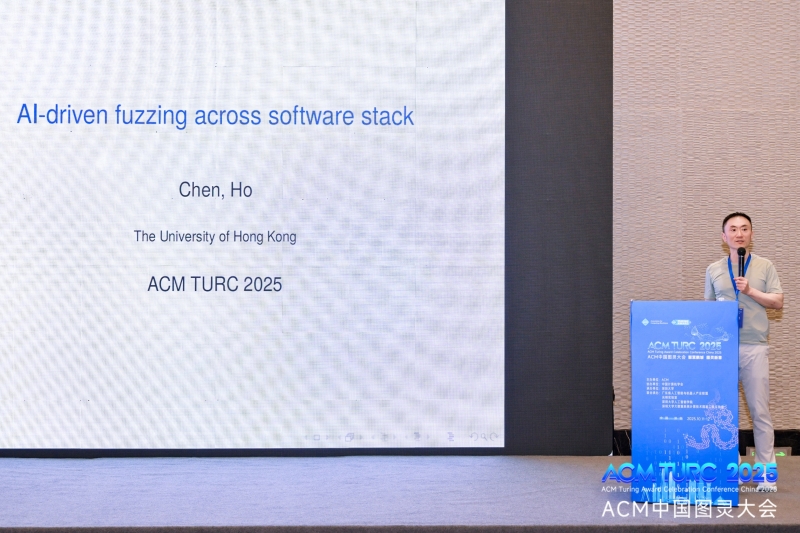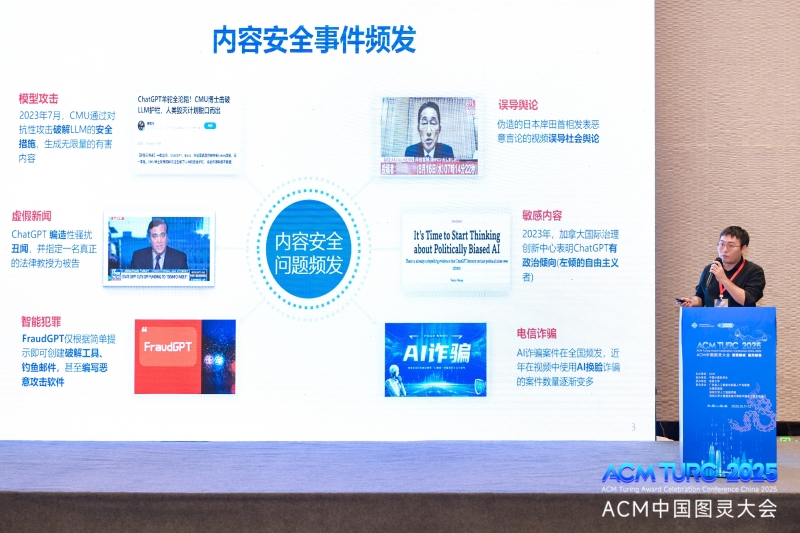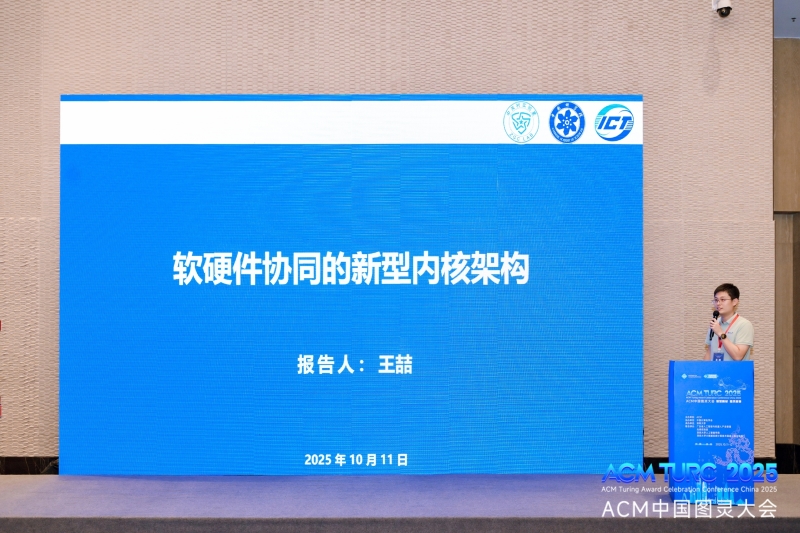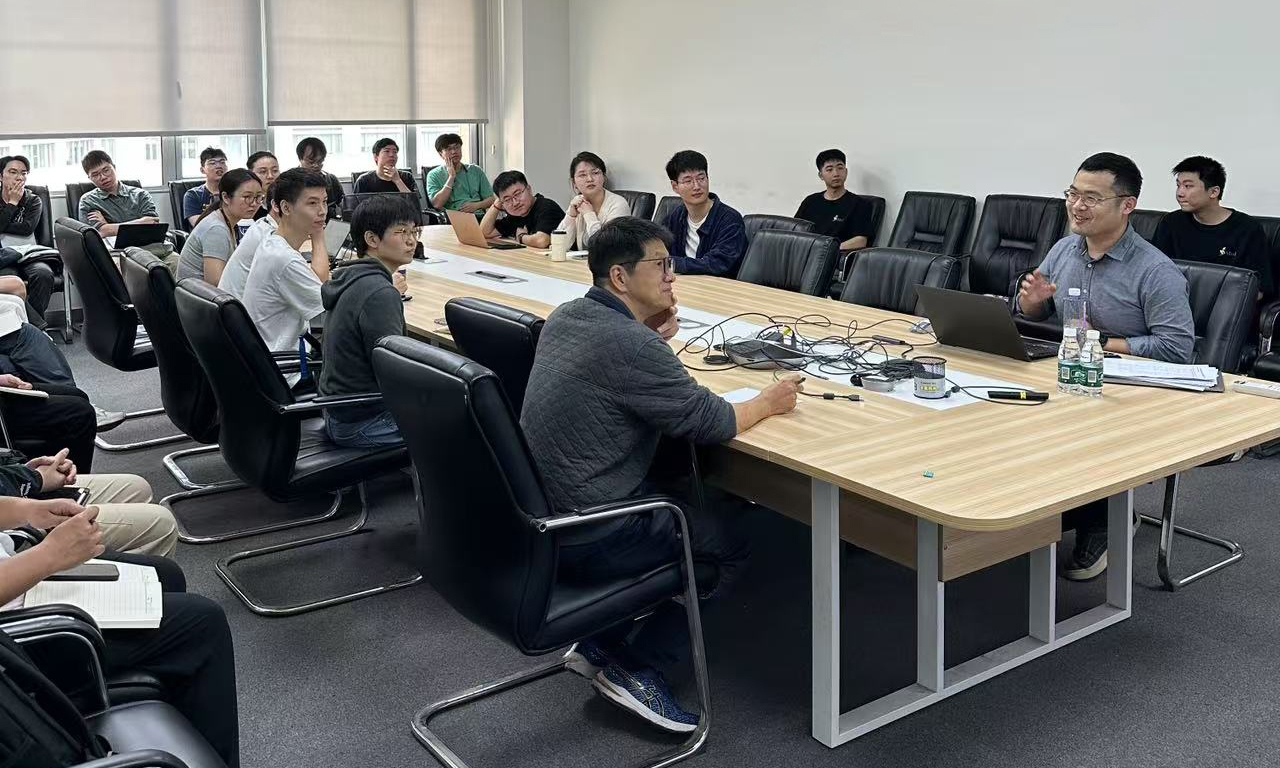From October 11 to 12, 2025, the ACM TURC 2025 – ACM SIGSAC CHINA was successfully held at the Hilton Garden Inn Shenzhen World Exhibition & Convention Center. The event was organized by ACM SIGSAC China and co-organized by the Research Institute of Trustworthy Autonomous Systems (RITAS).
The institute hosts the Information Security Research Center, which focuses on areas such as Trusted Privacy-Preserving Computing Platforms, Trusted Intelligent Computing Architecture (RISC-V-based), and Software and Hardware Security Vulnerability Analysis. The conference was attended by Prof. Joseph Sifakis (the Director of the Research Institute of Trustworthy Autonomous Systems), Prof. Yinqian Zhang (the Director of Information Security Research Center), Prof. Fengwei Zhang, and Prof. Jianyu Niu.
Prof. Ho Chen from the University of Hong Kong delivered the opening keynote titled “AI-driven Fuzzing across the Software Stack.” He systematically explored how AI technologies can be applied to fuzz testing at different levels of the software stack. Prof. Chen categorized the stack into Applications, Libraries, and Compilers, introducing his team’s research and results in each area. He concluded that, despite the need to mitigate the influence of AI “hallucinations,” AI’s strengths in search, optimization, and generation have already significantly advanced fuzz testing across all layers of the software stack.
Dr. Hongliang Tian from Ant Group gave a keynote titled “The Compilation-time Security Revolution – New Opportunities for Operating System Architectures.” He discussed how to build safer and higher-quality operating systems, emphasizing that the Rust language uniquely combines speed, safety, and efficiency. Rust, he argued, would be the optimal choice for eliminating most security vulnerabilities at compile time. Based on this idea, he introduced Asterinas, an OS kernel jointly developed by four organizations over three years with 120,000 lines of code. He stated the project’s goal: to create an advanced, open-source, and fully China-originated Linux alternative.
Following the keynotes, Zhongjie Ba (Zhejiang University) and Zhe Wang (The Institute of Computing Technology, Chinese Academy of Sciences) also presented academic reports. Zhongjie Ba’s talk, “Large Language Model Content Security: Frontiers and Challenges,” focused on synthetic trace detection and content violation control. Zhe Wang’s presentation, “A Novel Kernel Architecture for Hardware-Software Co-design,” analyzed limitations in the Linux kernel and proposed HAOC, a dual-layer kernel structure leveraging processor privilege-level access control.
Panelists included Prof. Xiuzhen Cheng (Shandong University), Prof. Haojin Zhu (Shanghai Jiao Tong University), Prof. Shouling Ji (Zhejiang University), Prof. Wei Wang (Xi’an Jiaotong University) and Prof. Ting Liu (Xi’an Jiaotong University). During the panel discussion, they debated thought-provoking questions such as: "Does openness inherently imply insecurity?","How can AI remain both intelligent and controllable? ","When AI begins autonomous reasoning and decision-making, how can we ensure its behavior aligns with human intentions and safety boundaries?".
The day concluded amid lively discussion.
The second day began with a keynote from Joseph Sifakis, Distinguished Visiting Professor at SUSTech and Director of the Research Institute of Trustworthy Autonomous Systems, titled “Testing Autonomous Systems – What Really Matters and What Doesn’t.” In his speech, he emphasized that testing for autonomous driving systems must go beyond traditional methodologies. Because AI systems based on machine learning handle unstructured data, conventional formal verification techniques are often inadequate. Prof. Joseph Sifakis proposed a method called Criticality Ordering, which optimizes test-case selection by quantifying scenario risk indicators. His talk concluded that autonomous driving tests should rely on empirically validated scenario coverage, rather than unverified conceptual frameworks.
Prof. N. Asokan from the University of Waterloo followed with a keynote titled “Blinded Memory.” He addressed the inherent tension between server-side code confidentiality and client-side data privacy during machine learning model deployment. His team proposed BliMe, an innovative hardware-software co-design that ensures privacy in outsourced computation. Moreover, compared to fully homomorphic encryption and multi-party computation, BliMe demonstrated higher efficiency on a RISC-V processor prototype, while resisting covert channel attacks. It offers a performance-privacy trade-off solution applicable to federated learning and cloud computing.
A second panel invited Prof. Wei Wang (Xi’an Jiaotong University), Prof. Hongwei Li (University of Electronic Science and Technology of China), Prof. Xinyi Huang (Jinan University), and Prof. Qi Li (Tsinghua University). They discussed whether AI could act as a catalyst for cryptography research, and what new opportunities it brings to protocol analysis and attack detection. Panelists also shared insights from their own research areas, examining the practical challenges of applying AI in security studies.
The workshop concluded with presentations from several ACM Rising Star and Excellent Doctoral Dissertation Award winners:
·Zhikun Zhang (Zhejiang University): Content Security in Large Language Model Generation
·Xiang Li (Nankai University): AI-assisted Logical Vulnerability Detection in Domain Name Systems
·Xin Tan (Huawei Cloud): AI-based Hidden Patch Identification and Industrial Applications
·Jiangyi Deng (Huawei): Voiceprint Security Based on Human-Machine Perception Differences
ACM SIGSAC (Special Interest Group on Security, Audit, and Control) is a professional branch of ACM devoted to computer security, auditing, and control. The successful conclusion of this workshop not only enhances research excellence in computer security and related fields but also strengthens SUSTech’s influence in these domains. Serving as a platform for academic and industrial collaboration, the event will continue to foster interdisciplinary synergy between academia and industry.





















